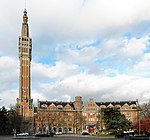Zénith de Lille
Indoor arenas in FranceMusic venues in FranceSports venues in Lille

The Zénith de Lille (or Zénith Arena) is a multi-purpose indoor arena in Lille, France. Designed by the Dutch architect Rem Koolhaas with Cecil Balmond and inaugurated in 1994, the Zénith Arena is a part of the cultural complex Lille Grand Palais which includes two other spaces: a Congress Center and Exhibition halls. Rem Koolhaas surrounded himself with Renz van Luxemburg for the acoustic studies, dUCKS scéno for the scenography and Arup Group for the engineering studies. Its ability to seat up to 7,000 people makes it one of the largest venues in Lille. The closest métro station is Lille Grand Palais.
Excerpt from the Wikipedia article Zénith de Lille (License: CC BY-SA 3.0, Authors, Images).Zénith de Lille
Boulevard des Cités Unies, Lille Euralille (Lille)
Geographical coordinates (GPS) Address Nearby Places Show on map
Geographical coordinates (GPS)
| Latitude | Longitude |
|---|---|
| N 50.633611111111 ° | E 3.0775 ° |
Address
Lille Grand Palais
Boulevard des Cités Unies 1
59000 Lille, Euralille (Lille)
Hauts-de-France, France
Open on Google Maps








